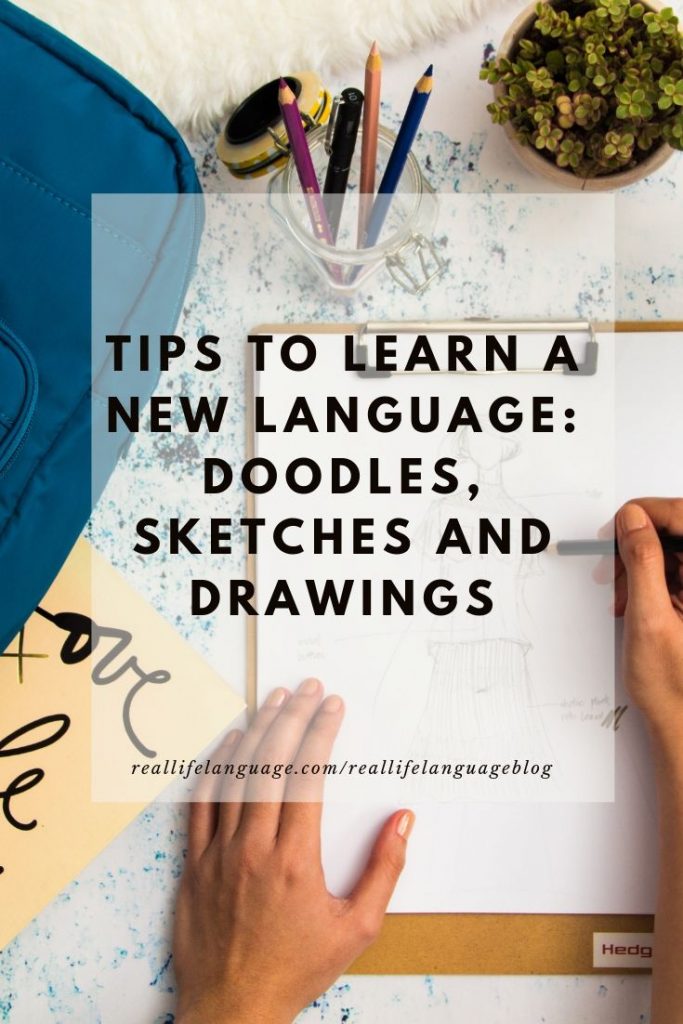
Tips to Learn a New Language: Doodles, Sketches and Drawings
One of my favorite tips to learn a new language that I love to share is the power of doodling. I consider it a powerful form of journaling.
Journaling daily will have a great impact on your fluency. Keep some form of a personal journal for your studies. It can be part of the task notebook, communication journal or something separate. Do whatever you need to develop the language that you want to learn.
Consider using themed vocabulary from a traditional textbook or a workbook of themed vocabulary. While it is not time spent on authentic communication with another person in the target language, it can be a great way to get some input and build skills during time that would otherwise not be spent in the target language.
You can do some very fun journal entries using themed vocabulary lists. Here are a few of my favorites:
A salad: Draw a salad. Using a themed vocabulary list, label all of the fruits and vegetables you included. Next, use the visual to write about your salad in as much detail as possible.
My Body/My Face: Sketch out a person. Label everything that you can. Use the illustration as a prompt to write about yourself.
A Person Made of Food: This is a fun one that requires some thought and engagement in vocabulary. Basically, you create a person made of drawings (or clip art) of foods. You then create a key using the names of the body and face parts and the food vocabulary you used to represent the face and body. You then use your creation as a prompt to write as detailed a description as possible. This also gives you an opportunity to learn about different types of foods from the target culture.
Portrait: Draw a picture of yourself, or another person. Label everything you can. Next, write as much as you can about the person.
Where I Live: This is quite self-explanatory. Sketch out where you live. Label everything you can. Write about where you live.
Variation: Do the same, but for your dream house or where someone else lives.
Likes and Dislikes: I love this for basic lists of vocabulary. You can categorize activities, classes, places in the world, foods, drinks, artists, music genres, books- anything you can imagine.
Schedules: Write out your daily schedule, a school schedule, a train schedule, or a movie schedule.
Dates: Write out important dates. These can be holidays, important dates in your life, important dates in the culture of the target language, or birthdays of family and friends.
An Alien (or Monster): Design your alien or monster. Describe this creation in as much detail as possible.
My Garden: Take a photo, or sketch your yard or garden. Label all of the items that you included. Write about what you see, talk about what you do there, and anything you would like to do there in the future.
My Family: I particularly like this one as one can keep this short and simple by only including immediate family, or it can be turned into an informative, extended project. Using photos or drawings, create a family tree. Write about each person, as well as their relationship to you. Including extended family can serve as cause to learn advanced vocabulary to talk about family, as well as a context to work in the past tense.
Nature: Draw or get photos of beautiful scenes of nature. These can become great stimuli for learning and using descriptive words and vocabulary for talking about nature and geography. It can become a cultural experience when the photos come from the target culture.
My School: This topic has so many possibilities. You can talk about any school that you have attended. The classes you took, liked and disliked make for rich stimuli for writing and vocabulary development. The people you interact with, or have interacted with in the past, can be writing topics.
This list is in no way exhaustive. The purpose is to get you thinking about how you can get working with the written word in your target language easily and in an enjoyable way.
Be sure to be consistent in how often you work in your journal. Set a period of time and write. Don’t stop to look up words you don’t know. The gaps are your built-in tests. Tests are there to see what you know and what you don’t know. Use your results to move forward.
I hope you have fun with these simple tips to learn a new language!
Looking for more resources? Click here.
I would like to learn Italian but my frirnds live in Sicilia which apparently has a different dialect to the normal Italian language if I am making sense. Please advise is it possible to learn the Sicilian dialect. Thanm you.
Dialects are variations within the same language. While there are differences, they are still the same language. For example, an English speaker can understand speakers from all over the world despite the differences. Here is an article that explains more in detail your specific question: https://theculturetrip.com/europe/italy/articles/the-key-differences-between-sicilians-and-italians/